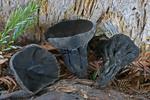
Coll. Jan. 2008
© F. Stevens | | | | | |
Urnula padeniana M. Carbone, Agnello, A.D. Parker & P. Alvarado, Ascomycete.org, 5 (1): 14 (2013).
Basionym Urnula padeniana M. Carbone, Agnello, A.D. Parker & P. Alvarado, Ascomycete.org, 5 (1): 14 (2013).
Diagnosis Ascome blackish, massive, fleshy, rubbery, up to 9 cm wide and up to 7 cm high, context gelatinous. Spores (23-) 25-30 (-32) × 11-13 μm, elliptical to slightly subfusoid, often slightly inequilateral, hyaline, smooth, with 1-3 (-4) guttules; paraphyses closely septate especially toward the tips; hymenial hairs straight, not-septate; flesh divided into a brownish subhymenium of thick textura intricata, a medullary excipulum of loose, hyaline, highly gelified textura intricata, a brown ectal excipulum of textura globulosa to subglobulosa; external hairs mainly hyphoid, heavily encrusted by a brownish crystalloid pigment, but also olivaceous true hairs are present, although in a less percentage. Differs from Sarcosoma globosum in black colors and the absence of moniliod external hairs; from Plectania species in bigger size, more gelatinous flesh, and a different morphology of the external hairs. Holotype in Washington University Herbarium, accession number WTU-F-33051.
Type WTU F-33051 - holotypus
MycoBank 801355
Notes
1) U. padeniana corresponds to Sarcosoma mexicanum in the sense of Paden & Tylutki (1969).
Literature
Carbone M., Agnello C., Parker A. 2013. Urnula padeniana (Pezizales) sp. nov. and the type study of Bulgaria mexicana. Ascomycete.org, 5 (1): 13-24.
Medel R., Chacón S. 2000. Contribución al conocimiento del género Plectania (Pezizales, Sarcosomataceae) en México. Acta Botanica Mexicana, 50: 11-19.
Paden J.W., Tylutki E.E. 1969. Idaho Discomycetes. II. Mycologia, 61 (4): 683-693.
Classification: Sarcosomataceae, Urnula
Created on 30/05/2015.
Updated on 02/08/2023.
